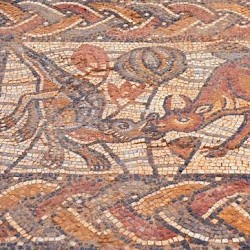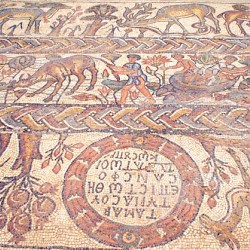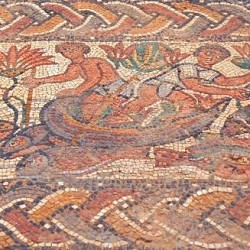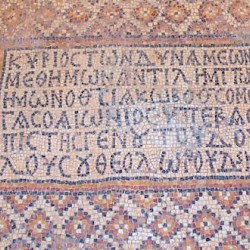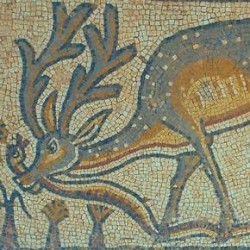Theodorias, East Church
Theodorias (modern Qasr Libya): Byzantine city in the Cyrenaica, (re)founded in 539 CE by the emperor Justinian. Two churches have been identified; the floor mosaics in the eastern basilica are among the greatest artistic treasures of Libya.

The floor of the East Church of Theodorias was covered with fifty small mosaics (the square holes in the floor on the photo to the right), which covered a surface of 10½ x 6 meters. These mosaics illustrated Christian salvation, while simultaneously representing the refounding of the city by the emperor Justinian in 539 CE: you can recogize personifications of Foundation (Ktisis), Adornment (Kosmesis), and Renewal (Ananeosis). The set of mosaics has been transferred to the museum opposite the Western Basilica. There was a second mosaic in an annex room, which we will discuss below and can be seen in the same museum.

In front of the Eastern Basilica was an atrium, surrounded by porticoes. Here, people could prepare for the sacred rituals that would take place in the church.
First Mosaic
Those who entered the church, would first notice a mosaic that represented the Pharos (lighthouse) of Alexandria, which compared the salvation offered by the church to the salvation offered by a good port. Moving to the center, the visitor would see a peacock, which symbolized the resurrection. A representation of Orpheus, theThracian singer who defeated death, makes the same point.
Moving closer to the apse, one would see the four rivers of the Garden of Eden:note the designer wanted the visitors to identify the sacred space with Paradise. These four rivers are called Euphrates, Tigris, Gihon, Pishon. The Gihon was believed to be identical to the Nile, the Pishon to the Danube.
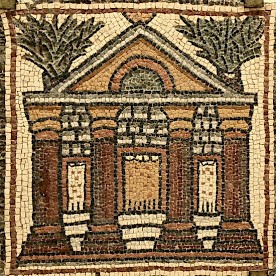
It is interesting to notice that the designer included classicals motifs. Orpheus has already been mentioned. The Castalian Spring was a source near the Greek oracle at Delphi and represented wisdom. By coupling Castalia to the Biblical rivers, the designers presented both Greece and Israel as sources of inspiration. This was not uncommon in early Byzantine art, nor was it limited to Christianity: in the synagogues of Galilee, we can see pagan motifs like Helios and the Zodiac next to scenes from Jewish history.
In other words: the church offers salvation, and God's love for humankind is so great that even before Christ, it had manifested itself in Greek and Jewish wisdom. Other artistic motifs reinforce this message of universality. By combining Nilotic scenes, zebras from Sub-Saharan Africa, Greek motifs, and the rivers of Eden, the artist has represented the three continents. And of course many kinds of animals show the beauty of God's creation.
Second Mosaic

In the annex to the north of the central nave of the East Church was a second mosaic, which is also on display in the local museum. No Christian message can be discerned in this mosaic. The central part is a Nilotic scene, with a crocodile attacking a cow. A peasant tries to draw away his cow, but will probably be no match for the crocodile. The right part of this mosaic shows fishermen with lotuses and a duck. The edge of the mosaic was decorated with all kinds of animals and plants, like a stag fighting with a snake (a motif also seen on the mosaic above).
The round inscription says that the building was finished in the third year of the indiction by a bishop named Theodore the Younger. The problem is that the inscripton on the mosaic above, which was made by the same artists, was made in the same third year (539 CE), by a bishop named Macarius. Probably, Theodorus was successor of Macarius.
Another inscription contains a prayer:
Lord of heavenly powers, abide with us as a helper, our God, great God of Jacob, eternal one, be protector of your servant Theodore the Younger, the Deacon.
The first line is a quotation from from Psalm 45.11.


















































